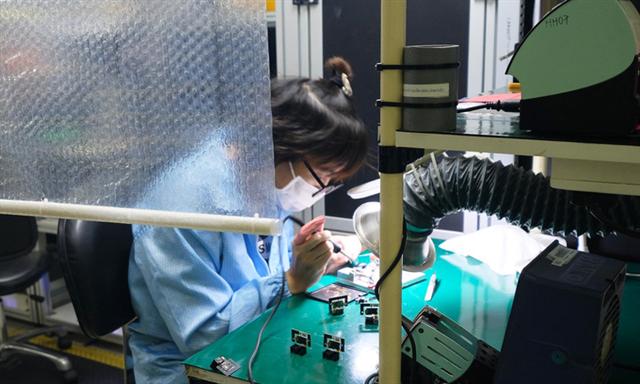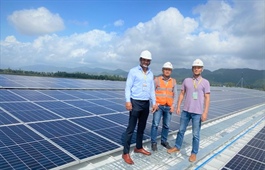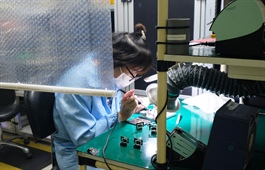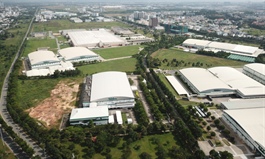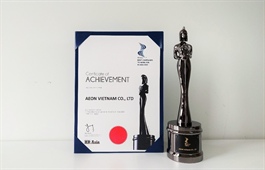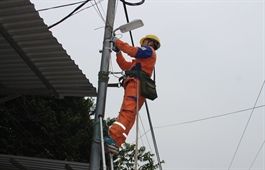Factories overcome hardship to resume production
Factories overcome hardship to resume production
The operation capacity increase of Datalogic Vietnam brought relief to its CEO Nguyen Tien Phat after months of limited production, even though he confronts worker shortages and lack of orders.
A worker is seen at the factory of Datalogic in Ho Chi Minh City. Photo by VnExpress/An Phuong |
The HCMC-based electronics manufacturer company has seen its workforce grow from 40 percent to around 60 percent after the city eased social distancing earlier this month.
"We plan to recruit and welcome employees back to the factory, and expect productivity to return to 80 percent in the last months of the year," Phat told VnEpxress International.
The company’s current goal is to win back orders and seek more customers, he added.
Since HCMC started reopening its economic activities earlier this month, companies have been trying to increase their production, boost manufacturing in the last quarter after three months of limited operations.
With 74.5 percent of the adult population fully vaccinated, the city is gradually lifting restrictions to "live with Covid-19," as the new normal and trying to avoid another citywide closure.
Businesses under the Food and Foodstuff Association of HCMC are working to recover production from the current 50 percent of capacity to 80 or even 100 percent by the end of the year.
Many companies are also targeting the domestic market, expecting to see rising demand in the remaining months and in the Lunar New Year holiday which runs from late January to early February, 2022, the Government News Portal quoted chairwoman of the association Ly Kim Chi as saying.
But several difficulties remain for businesses to fulfill their plans.
Japanese companies in Vietnam want to reach total capacity as soon as possible, but because the stay-at-work scheme is still in place, companies need to submit dozens of documents to comply with the regulations, said Takeo Nakajima, chief representative of Japan External Trade Organization (JETRO) Hanoi and vice-chairman of Japan Business Association in Vietnam (JCCI).
"It takes time. We still wait and see how business activities will resume after restrictions are lifted," he said, noting that while some companies are back to normal others have not resumed operations.
Many workers cannot commute to factories, and a large number of employees who left for their hometown will not return anytime soon, he said, adding that delays continue in cross-border delivery of parts and materials.
"We do not have data on the Japanese companies' revenue and profits in 2021. But I won't be surprised if it would be one of the lowest ones in decades," Nakajima said.
As HCMC authorities relax their control and ask companies to take responsibility for curbing the spread of Covid-19, some companies playing safe with their reopening, waiting for the pandemic situation to come under better control before resuming full capacity.
Sewing machine maker Juki Vietnam in District 7 has said it will continue with the stay-at-work model to ensure production is not interrupted.
The company is compiling data of all its employees to report to the Ho Chi Minh City Export Processing and Industrial Zones Authority (HEPZA) so it can resume full production soon, said CEO Dao Quoc Cuong.
Other companies are experiencing labor shortage as a serious hindrance.
Datalogic Vietnam is having difficulties recruiting employees to the positions of managers and quality inspectors. Other challenges it is facing include a global shortage of components, shipping costs increasing every week and transportation delays.
Expensive reopening
"To meet [reopening] requirements, our business has to spend a huge amount of money," Phat said, referring to the cost of testing all of its on-site workers to get them the green pass, a work permit which contains all Covid-related information of the holder.
Costs like building temporary houses and transportation to bring workers back were not part of the original expense plans for the year and will likely eat into profits.
For South Korean companies in HCMC and neighboring provinces, the immediate target is to increase production capacity, which is currently at 20-30 percent of pre-pandemic levels.
"The short-term goal is to try and gradually adjust to the new normal," said Lee Jong Seob, president of the Korea Trade-Investment Promotion Agency (KOTRA) in Southeast Asia-Oceania and general director of KOTRA in Hanoi.
The main challenges Korean companies face are increasing transportation costs, financial burden due to stay-at-work and testing expenses, and labor shortages, he said.
"The fact that many workers have returned to their hometown gives business owners the headache of bringing them back for resuming production."
Lee proposed that the government facilitates the interprovincial movement of workers so they can travel back to the city for work.
Also, a free flow of goods should be ensured as the current procedures for logistics and shipment are both time consuming and very expensive, he added.
"There should be more support policies for businesses to reduce business costs, in the form of credit support, tax exemptions, extensions, etc."
Nakajima said Japanese companies need more guidelines in acquiring the green pass as many are not sure if employees who have received one vaccine shot can return to work or whether two shots are mandatory.
The "post-fourth wave period" will be a crucial one for Vietnam in regaining its reputation and the confidence of international investors. It has to send a message that it is still a safe country to do business.
"If Vietnam continues to impose stringent containment policies, foreign investors' assessment of the country will be more negative even when a significant portion of the nation gets the second vaccine," Nakajima said.
Reopening the border is also a critical question for multinational enterprises, as experts and engineers need to travel in and out of Vietnam freely, he added.
The government this week issued a new set of regulations on controlling Covid-19, assuring goods could be transported freely between localities, while manufacturing facilities operate despite the local severity of the pandemic.


